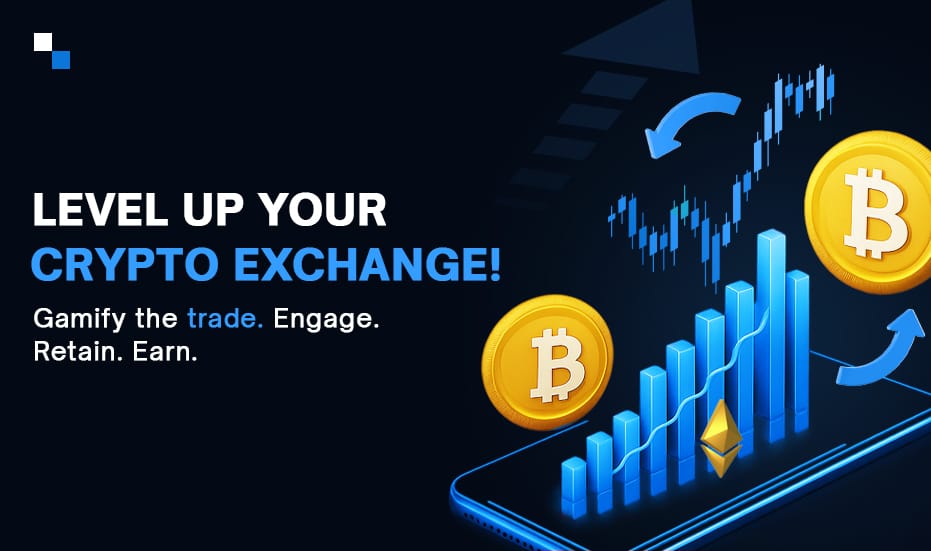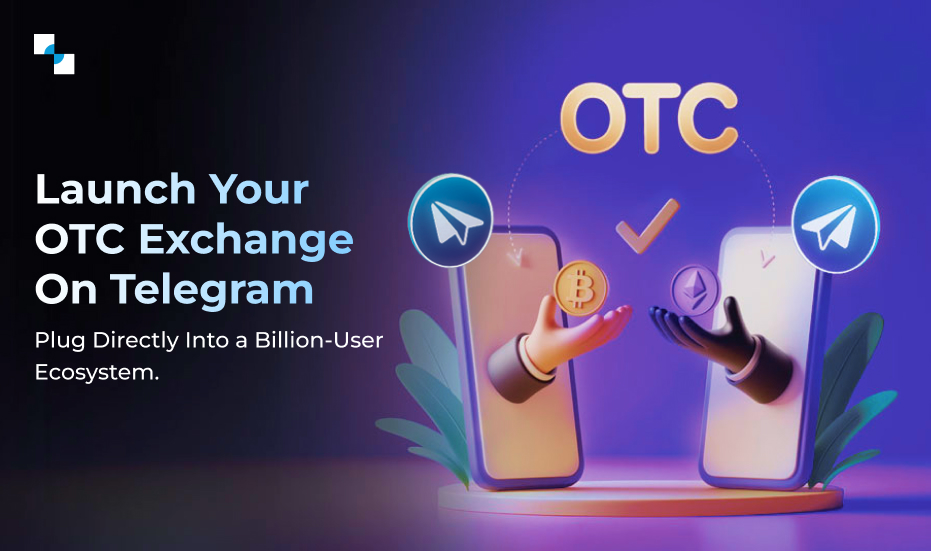Introduction
Gamification is the use of game design techniques (such as in-app games, challenges, and rewards) in non-game contexts. It has been around the crypto and blockchain space for a while now. But in 2025, it’s no longer experimental. With several successful case studies setting new benchmarks and more innovations on the horizon, platforms built around cryptocurrencies and stablecoins are getting inspired and embracing gamified experiences. Whether you’re planning to develop a new cryptocurrency exchange software or breathe new life into an existing one, transforming trading from a chore into an immersive and rewarding experience should be on your product roadmap.
Why Gamification Matters For Crypto Exchange Development?
“In a hyper-competitive market, Crypto Exchange Development is no longer about ‘just working’ — it’s about keeping users hooked. Think beyond the trading pairs and token launches and make your platform sticky.”
Gamification taps into a basic human instinct- our love for competition, achievement, and rewards. And when applied right, it turns tedious trading from a dry activity into a lively, interactive journey. Instead of users passively opening an app to check prices, they’re now actively:
- Completing missions
- Earning tokens
- Climbing leaderboards
- Unlocking badges
For crypto startups and emerging crypto exchange development projects, adding game-like, playful mechanics adds a powerful way to stand out in a saturated market. These small, bite-sized challenges create daily engagement loops that users want to return to. In a space where user retention is tough, that’s a big win, which is exactly why any exchange needs such a feature in a competitive market.
The impact? Crypto businesses have been drawing some real, measurable business benefits from it. Here’s what crypto exchange development projects are cashing out of the gaming mode-on strategy:
- Higher Active Users: When trading becomes a winning experience, raising the dopamine levels every time, users log in more frequently and explore more features. As per a survey, exchanges that implemented gamified features reported a surge in user activity and engagement rates. Gamified crypto platforms saw a 73% increase in daily active users compared to those without any game elements.
- Higher Retention: Gamified experiences encourage users to stay longer and return regularly. Marketing research in the Web3 space shows that well-crafted quests and reward programs improved user retention by ~43% on average. Keeping users engaged through fun tasks means they’re less likely to drift away to competitors.
- Increased Trading and Volume: More things to do translate to more time in-app and more trades. More trades mean more fees. A little friendly trading competition can go a long way in enhancing the trading volume. For example, Bybit’s global trading tournament turned trading into a game and saw over 77,000 participants and $100 billion in trading volume during its 2024 event. The promise of rewards and recognition can dramatically boost trading activity on the platform.
- Community Building: Gamification often includes social elements-referrals, team challenges, and leaderboards. According to Web3 marketers, interactive campaigns (like referral races or NFT treasure hunts) can raise community activity by over 60%. Users aren’t just trading; they’re participating in a community, which builds loyalty and word-of-mouth buzz.
With effective gamification strategies, cryptocurrency exchange software platforms can also nudge users to complete KYC, trade more, refer friends, or stake. These tactics attract users, keep them engaged, and encourage them to trade more, ultimately unlocking higher liquidity and revenue levels for crypto exchange development projects.

Gamification in Action: Case Studies from Top Cryptocurrency Exchange Software Platforms
It’s not just theory – many leading exchanges are already winning with gamification. Let’s look at how real-world crypto exchange software platforms like Binance, KuCoin, and Bybit have successfully embraced in-app gaming features to engage their users:
1. Binance – Rewards, Quizzes, and Challenges
Binance, the world’s largest exchange, has woven gamified experiences throughout its ecosystem. In 2024, Binance launched a Ramadan-themed campaign with daily surprises and community tasks, featuring over $400,000 in rewards for participants. Each day, users unlocked a new “door” in a digital Ramadan Calendar, revealing activities like
- Trivia quizzes
- Trading challenges
- Charity events
-All designed to inspire, unite, and reward the community. This kind of seasonal event not only drives engagement (with thousands of users participating daily) but also reinforces a sense of community and shared purpose.
Binance didn’t stop there. The cryptocurrency exchange software platform also runs ongoing “Monthly Challenge” missions, where users complete simple trading or learning tasks to earn Binance Points, which are loyalty points redeemable for crypto vouchers and other perks.
By incorporating these mini-games and “earn as you learn” programs, Binance makes the user journey more interactive. New users get a fun introduction (like educational quizzes with prizes), while seasoned traders have continuous incentives to engage beyond just the profit motive.
2. KuCoin – Social Mini-Games to Engage Traders
KuCoin has taken a creative leap by integrating actual games into its crypto ecosystem. In August 2024, KuCoin launched “xKuCoin,” a next-gen mini-game tied into its crypto exchange software platform. This quirky, Telegram-based social meme game lets users feed an adorable virtual frog to earn “Frog Points,” with points boosted by inviting friends and completing little missions.
It might sound lighthearted, but it’s a strategic move: every friend referral and action in the game loops back to greater engagement with KuCoin’s exchange services. This, therefore, becomes a great inspiration for crypto exchange development projects. Users have fun, compete on scoreboards, and in the process become more active in the KuCoin community.
The mini-game became a talking point among the community, driving social media buzz and attracting users who might not otherwise log in frequently. KuCoin’s gambit demonstrates that even a serious crypto exchange can lighten up and engage users on a more personal, entertaining level, all while promoting platform stickiness.
3. Bybit – Turning Trading into a Competitive Sport
Bybit, a leading crypto exchange software, has approached gamification by tapping into traders’ competitive drive. Its flagship event, the World Series of Trading (WSOT), transforms trading into a global esports-like competition. In the 2024 WSOT, Bybit offered a hefty prize pool (around $10 million) and gamified the entire experience with team-based and individual contests. The result was staggering: over 77,000 traders from 160+ countries participated, logging more than $100 billion in trading volume during the event.
This not only shattered records for Bybit but also proved the power of gamified incentives. Traders formed teams, strategized to top the leaderboards, and shared in the excitement, much like a massive online tournament. The WSOT shows that users respond enthusiastically to competitive gamification, especially when real rewards are on the line.
Off the back of this success, Bybit continues to infuse game elements elsewhere (like limited-time trading challenges, badge achievements for completing tasks, and referral races). The lesson is clear: a bit of competition, some attractive rewards, and a well-designed game structure can turn a standard trading platform into a dynamic arena that traders want to be a part of.
4. Korea’s LOT platform:
Another prominent crypto exchange development project that became popular was Korea’s LOT. The exemplifies successful gamification, with users spending an average of 45 minutes per day on the platform, significantly higher than the industry standard of 15-20 minutes for traditional crypto exchanges. The platform was ranked as the most user-friendly cryptocurrency trading platform in South Korea, with 78% of respondents citing gamification features as their primary preference driver.
Must-Have Gamification Features and Mini-Games
“Mini-games turn passive traders into active participants. And prompt active users to trade more.”
Stop just improving your boring dashboards. Today’s users expect interaction, and these exciting gamification features and mini-games are the best power-up for your cryptocurrency exchange software platforms.

The key to success? Seamlessly integrating these into your crypto exchange development workflow, without disrupting your core trading experience.
Tech Behind Gamified Crypto Exchange Development
“Do you know?
Blockchain games bring 230K users as DePIN hits $18.9B”
To build next-gen, game-like features into your exchange, a strong technical base is critical. Here’s a recommended stack used by leading cryptocurrency exchange development companies:
- Frontend: React / Flutter (for immersive mobile interfaces)
- Backend: Node.js + Redis (fast real-time processing)
- Blockchain SDKs: Ethereum, Solana, Polygon (for NFT/game asset integration)
- Gamification Layer: Unity or custom-built modules
Whether on-chain or off-chain, performance matters. You want games that load fast and sync in real time.
Who Benefits From Gamified Crypto Trading Experiences?
When done right, in-app gaming elements turn a regular trading platform into a vibrant community where users feel motivated to engage and stick around. But who’s getting entertained with this cryptocurrency exchange development addition?
Thinking this is only for “young traders”? Think again. It’s everyone who’s leveraging mobile cryptocurrency exchange software applications. So, who benefits from gamified cryptocurrency exchange software development?
Who benefits:
- New crypto startups looking to go viral
- Centralized exchanges are improving retention
- Web3 projects launching interactive tokens
- DeFi trading apps with staking + community features
No matter the size of your platform, gamification in cryptocurrency exchange software gives you an unfair advantage.

Embrace the Era Or Risk Falling Behind
The takeaway for startup founders and product teams is inspirational and clear: Gamification is not a gimmick; it’s becoming a must-have in modern crypto exchange development for growth, retention, and monetization. If you’re building or upgrading a trading platform, consider how you can integrate these in-app gaming features from day one.
Balance fun and function and climb the UX scoreboard. The goal isn’t to turn serious traders into full-time gamers, but to enhance the overall user experience. Gamification should complement the core trading activities, not distract from them.
For instance, offering a badge and a fee discount when a user completes their first 10 trades can encourage newbies without overwhelming them.
To implement gamification effectively, many exchanges are turning to expert cryptocurrency exchange software development companies for help. A tech partner like Antier understands the ins and outs of building engaging, gamified platforms and also has experience building the most high-performance trading engines. And what’s more exciting is that you don’t need to build everything from scratch if you don’t want to reinvent the wheel.
The best cryptocurrency exchange development companies now offer:
- Pre-built gamification module
- Custom mini-game development
- Smart contract integration for rewards
- Mobile-first design for higher engagement
They combine deep experience in crypto exchange development with modern UI/UX principles essential for building addictive in-app game experiences.
If you’re building or scaling your exchange, it’s time to rethink engagement, not just execution. Don’t just be another crypto app. Be the one users enjoy opening.
Let’s Build Your Next-Gen Crypto Platform Today!







